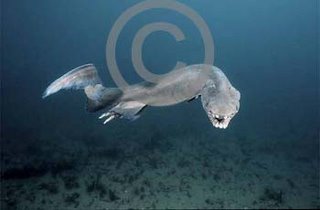A year or so ago I started reading a lot about giant squids, and inevitably got intrigued by accounts of sea serpents, especially ones purported to inhabit the cold waters along the New England coast. While most of these sightings were Victorian-era, some were surprisingly recent.
The most recent I've found of late is on the
Unmuseum page, circa 2002:
"I work for a science museum and recently got a phone call from a woman who is insisting that she saw something called the Biddeford Sea Monster which is Maine's equivalent to the Loch Ness Monster. Do you know anything about this legend? Until she called me I had never heard of it.
- Anonymous
Your caller may have been referring to the sea serpent that reportedly haunted the coves and bays along New England during the 18th, 19th and much of the early 20th century. Though a listing of sea serpent reports from that era shows none specifically for Biddeford, nearby Kennebunk, Wells Beach, Kittery, Casco Bay and Portland all have multiple sightings associated with them. All in all over 200 reports were made during this period and even today nobody is quite sure of what people were seeing.
A good place to start with learning about the phenomenon is our own page, The Monstrous Sea Serpent of Gloucester, and J.P. O'Neill's excellent volume The Great New England Sea Serpent. If you caller indeed sighted the creature it will be welcome news for serpent supporters who have been concerned that over-fishing along the coast my have deprived the animal of its food supply and driving it away from the coast."
----------------------------------------------
Loren Coleman, as usual, is way ahead of me. Back in 1958 a sea serpent was spotted in Casco Bay just off of Portland, and many years later the witness approached him with his story. The account was re-published in the Portland Press Herald on October 30, 2005. I guess they never got any really good local ghost stories in time for Halloween, and went for the monsters instead. Though they don't mention it in the article, the adopted moniker for our local sea serpent is Cassie (for Casco Bay), according to Mr. Coleman.
Sunday, October 30, 2005
Sea serpent in Casco Bay?
Copyright © 2005 Blethen Maine Newspapers Inc.
Here is an excerpt from "The Field Guide to Lake Monsters, Sea Serpents, and Other Mystery Denizens of the Deep," co-authored by Loren Coleman and Patrick Huyghe.
DATE: June 5, 1958
WITNESSES: Ejmar Hairgaard, Ole Mikkelsen
LOCATION: Casco Bay, Gulf of Maine
In 1985, an elderly Scandinavian man cautiously approached the speaker who had just given a talk on cryptozoology before the Appalachian Mountain Club. The man told the speaker, Loren Coleman, that a friend of his had seen a Sea Serpent. The man was Ole Mikkelsen of Portland, Maine.
When Coleman interviewed Mikkelsen, the fisherman began to relive his experience, the date exploding from Mikkelsen's lips: "The fifth day of June 1958! I won't soon forget it."
In 1985, Mikkelsen was not only trim, muscular, and tanned, but alert and active for a man of 81. He told Coleman that he had been fishing since he was six and continued to do so up through 1984. Born and raised in Denmark, he had come to Maine in 1923, and he knew the waters of Casco Bay well. But he had never seen anything before 1958 to prepare him for the monster he saw that June.
The fifth had started like most workdays for Mikkelsen. Up early, he and his partner, Ejmar Hairgaard, since deceased, were out to sea before daybreak. Mikkelsen recalled that it was about a half hour after sunrise, about 6 a.m., when they first saw "it." They were about five miles off Cape Elizabeth, only about one and a quarter miles south of the Portland Light Ship.
"Suddenly," Mikkelsen recalled, "we saw an object coming toward us out of a haze; we took it to be a submarine, but as it came near we discovered it was some live thing. As it came still nearer it dove down and a tail came up out of the water, and slowly it went down again. In about three or four minutes it surfaced again, came near us, and dove again. Then it came up once more about 125 feet away from us and stopped as if to look us over."
At that point, Hairgaard shouted, "Give me the knife; if it comes nearer, we'll cut the nets and run for the lightship!"
"But luckily," Mikkelsen said, "it decided to swim in a nice turn to the south of us. We saw it disappear to the southeast in the haze."
Not surprisingly, Mikkelsen's metaphors and frames of reference related to his years of fishing. He said the thing's color was like that of a cusk, a light-brown North Atlantic food fish, with a lighter underside to its neck. He said the tail was like a mackerel's. But of course, he knew it was not a cusk or a mackerel.
Mikkelsen was certain that what he saw was well over one hundred feet long. The head stuck out of the water and was broader than the long neck it was on. He could not pick out any ears or eyes, but he is certain it could hear.
Mikkelsen reported that every time the Portland Light Ship blew its mournful foghorn, as the anchored Coast Guard vessel did regularly, the creature turned its head in that direction. Hairgaard and Mikkelsen had the creature in view for more than 45 minutes, and they regularly saw the creature's head rotating toward the sound of the lightship's horn.
The Mikkelsen report fits well into the body of reports dating back to the eighteenth century from the waters northeast of Maine, in Broad Bay in 1751 and in Penobscot Bay in 1779, when Sea Serpents were sighted by men fishing the same waters. During June and July 1818, fishermen told of seeing a Sea Serpent in Portland Harbor. Many sightings occurred off Woods Island, Maine, in the early 1900s. And Eastport, Maine, was the scene of encounters in the late 1930s and in 1940.
Sources: Interview with Ole Mikkelsen of Portland, Maine, by Loren Coleman, 1985; "Portlandiana: Casco Bay's Sea Serpent," Portland Monthly, May 1986; Loren Coleman, "Mysterious America: The Revised Edition (New York: Paraview, 2001).
Excerpt from "The Field Guide to Lake Monsters, Sea Serpents, and Other Mystery Denizens of the Deep," by Loren Coleman and Patrick Huyghe
Source
--------------------------------------------
Around the same time, I found to my amusement this morning, Chris D over at All Things Maine published an article on the Mount Desert Island sea serpent. I wonder if that 100-foot long mysterious skeleton found in 1819 is still in the neighborhood? I would love to see it.
---------------------------------------------
The 1800s seem to have been a very popular time for oceanic oddities in Maine, as another report, this time from New Harbor, Maine, shows. This was found on Strangemag.com as part of an excellent article called Bring Me The Head of The Sea Serpent! The creature described sounds absolutely fascinating. A real sea serpent, in effect!
The New Harbor "Sea Serpent"
In August 1880, a sea serpent of sorts was procured that apparently comprised a quite different but equally unknown species of shark. Captured dead by Captain S. W. Hanna at New Harbor in Maine, it was approximately 25 ft. long and 10 in. wide, and was shaped like an eel, with a flat head whose upper portion projected over its small mouth (containing sharp teeth, and positioned at the tip of its head), fine sharklike skin, an eel-like tail fin, a pair of small fins behind its head, a small triangular dorsal fin, and just three pairs of gills, which were not covered by a flap of skin.
Overall, therefore, it resembled an eel-like shark--in particular, a deepwater serpentine version called the frilled shark Chlamydoselachus anguineus ("snakelike shark with frills"), which, unlike most other species, does have a terminally sited mouth and a noticeably elongated body. However, the longest confirmed specimens of frilled shark do not exceed 7 ft.
Moreover, the New Harbor fish was additionally distinguished via its paucity of gill pairs--all modern day sharks possess at least five pairs. Clearly, therefore, Hanna's catch was a most significant one--which makes it all the more tragic that although its appearance was ultimately documented by an eminent ichthyologist, Prof. Spencer Baird, by that time the body itself had been discarded. No comparable specimen has been recorded since.

And you know, if I saw one of these little doggies coming at me in the water, I would be suitably terrified.
----------------------------------------
Another fine article is found in the Boothbay Register, reprinting an original account of the 1831 Boothbay sea serpent sightings. This is a wonderfully colorful account, including such eyewitness quotes as "Back they came, their eyes big as saucers, screaming, 'Mother, Mother, there's the biggest eel you ever see in your life, got into the cove (Fairy Cove).'"
The author of the article laments the common sense of the woman in question, saying "This was unquestionably a young serpent, and I only regretted at the time no attempt had been made to arouse him to some demonstration. Mrs. Chandler declared she 'expected every moment he would come on shore, and there was no telling what he would do.' " Hey, give the lady a break. (Although, it must be admitted that if a hypothetical Mrs. Chandler had provoked the beastie into untold acts, it would make a bang-up monster movie premise). Besides, how rude to harass a sea serpent. Have a little respect, there, mister!
--------------------------------------------
Finally, if I had not been dealing with my monstrous (ha ha) wedding, I would have had the excellent opportunity to improve my knowledge of the sassy sea serpents of Maine by attending the recent Cryptozoology Conference, at which J.P. O'Neill gave a talk on the subject, as reviewed in the Portland Phoenix. I don't suppose anyone out there videotaped it???
Well, let's hear it for giant, strange sea creatures in Maine. Here, here!!!
Have a great Thanksgiving, one and all.












